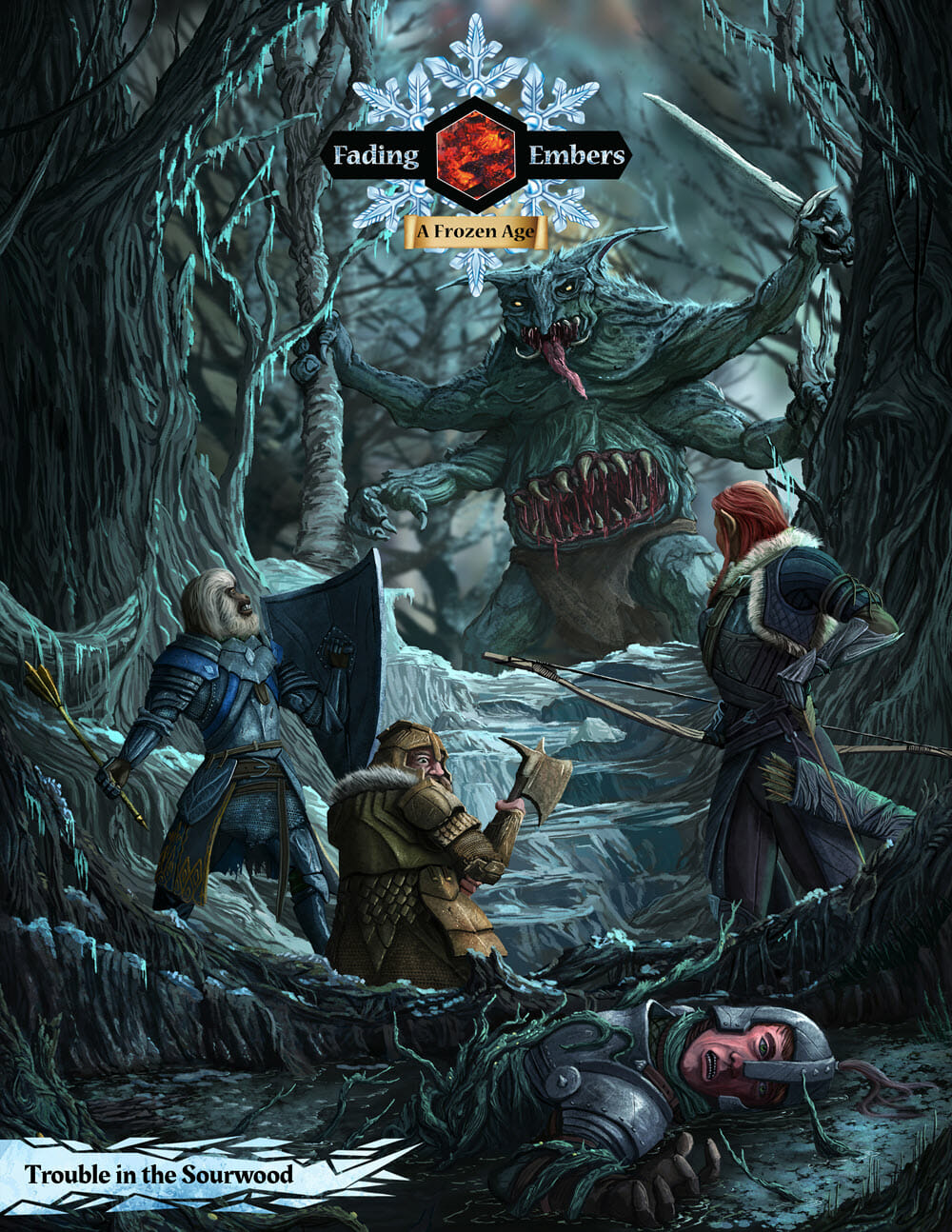Valiant Fox Gaming and author John Yackel publish the 5e setting Fading Embers. It’s a fantasy world set 900 years into an unnatural ice age and where survival is a challenge.

Sound fun? There’s a Pay What You Want Primer and an adventure coming called Trouble in the Sourwood.
Sourwood Bog, where foul corruption has taken root, will come to Kickstarter, and there’s a low-volume mail list to sign up, to score an extra discount on the Fading Embers Campaign Set PDF bundle. The mail alert will also keep you in the loop on the Kickstarter.
Corruption, you say? I’ve found that to be quite a complex topic to deal with beyond an excuse to insert monsters. Curious about Sourwood but worried about the subject, I asked John Yackel to lend me a hand.
He did, and it turns out that corruption might be unexpectedly wholesome in your RPG.
Introduction (to Corruption)
By John Yackel
Corruption comes in many forms. Regardless of differences, all of them are linked to the central premise that something once pure or good becomes infected, and slowly changes into something less than what it was, a damaged version of itself, often twisted into its very antithesis.
A short list of examples: a cancerous disease turning a healthy body against itself (physical), a judge deciding guilt or innocence for money (political), a once pristine landscape now covered in pollution (environmental), a protector who becomes an abuser (duty), a message of peace and love twisting into one of violence and hate (spiritual). The list goes on.
Corruption is a compelling theme for Role Playing Games because its scarier than mere death or destruction. Your party of characters facing off against an overwhelming tide of monsters is scary. If all those monsters are zombies it becomes way scarier, because now any PC who dies will also come back and join the zombies trying to kill everyone!
Famous Examples
The sci-fi/fantasy genre is brimming with examples of corruption-based villains. Some of the best villains are characters who were once the brightest heroes.
The extended Star Wars universe is full of jedi who fell from grace into the dark side. In Games Workshop’s Warhammer 40,000 setting, the course of humanity’s future changed when Warmaster Horus Lupercal betrayed The Emperor. In the World of Warcraft, Prince Arthas Menethil descends from heroic paladin into becoming the new Lich King.
Why It’s Great for Players
If you love getting into lots of drama in your role playing, corruption can generate a laundry list of messy situations guaranteed to shake up the status quo! Plead with your PC’s loved ones to reject their insidious religious cult. Let your PC struggle with the morality of egregiously breaking their principles to solve a problem. Perhaps your character will even rationalize and justify the actions after-the-fact. We’ve all heard the saying, “The road to hell is paved with good intentions.” Falling from grace and then clawing your way back is an epic arc for any character.
Some RPG systems even have built-in game mechanics to quantify corruption. In Legend of the Five Rings (L5R), it’s called Shadowlands Taint, and once a PC acquires any amount of taint, it will never completely go away. Affected spellcasters can even use their taint to boost their spells, powering up the spell effect, although to do so risks gaining another point of taint. (It’s just one little point, after all.)
Why it’s Great for GMs
Being a gamemaster is being a storyteller, albeit without control over the main characters. The process of corruption is typically a gradual thing, therefore lending itself very well to the process of an adventure or campaign unfolding. A problem that begins as foreshadowing can be noticed but ignored by PCs busy following the main plot, later developing into a full-blown crisis.
Many sources of corruption are not easily destroyed by player characters. How does a party of even the greatest heroes fight pollution, or a corrupt political system?
If the heroes are fortunate, and the source of corruption is an irredeemably monstrous creature, by the time it’s destroyed by the PCs it could already have infected others, further spreading the corruption. Using zombies as an example of corruption, even a gung ho PC killing zombie-bitten-people will likely pause upon spotting their friends or family in the throng of potential enemies.
Fading Embers
Corruption is such a versatile subject for role playing games, that it’s one of my personal favorites as a gamemaster. So much so that I made it one of the major themes in my frozen 5e setting of Fading Embers. It’s found in many forms, not always easily seen, across the world of Nyth. It is also the central theme in the upcoming adventure supplement ‘Trouble in the Sourwood’.

A mysterious source of physical corruption is seeping out of Sourwood Bog, spreading into the nearby Blacksalt Woods, and causing a multitude of dangerous problems for the townspeople of Veliko.
The landing page is handing out a discount on Fading Embers PDFs, and collecting emails to notify when the Kickstarter campaign launches.
Quick Links
- Sign up for occasional Sourwood corruption and Fading Embers news.

